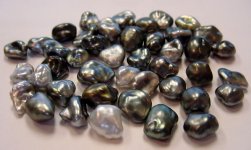smetzler said:
The impression given by the ability to purchase by the kilo is distinctly industrial?appears to be reflected in incredibly accessible Tahitian keshi pricing as well. Could Tahiti be in the process of flooding the "keshi" market the way they did beaded black pearls a number of years ago?
Most pearls are bought and sold by weight. A mixed lot of keshi would likely be priced by the gram and a kilo would be a workable lot- enough pearls to create a few different pieces. This is not to say a kilo of keshi would be cheap. Not as expensive as selection-buying, but definitely not cheap.
Keshi by selection can be quite expensive. But unless a farmer keeps something "special" from the harvest, keshis and rounds are all sold as lots. These lots are valuated (both in the Cooks and FP) by unit, average gram or momme weight per unit, grade and color. It is not until the pearls reach the B&M wholesale level, or even the retail level before they are valuated as single pearls or finished pieces (for the most part).
I don't think Tahiti is flooding the market with keshi. They are simply a bi-product on the pearling industry and intentional production is not common as far as I know. The current market price would not make it a viable option.
I don't recall exactly, but I believe Josh harvested about 30 kilo of keshi with his fall harvest. The size range is dramatic. Some are as small as 2 mm and others are quite large. Those in the photo above grew in two years.
I would not be concerned whether or not keshi are preconceived either. There is no difference in the pearl. They are still consiered "keshi" industry wide with no differentiation.
Too bad it was not an entire lost line. That would have been perfect if it did have a Cyclone Martin story attached to it!
Valeria101 said:
Why... there are several perfect pairs of earrings right there!
Earrings are too easy! I am not saying I want to do something difficult. But it would be fun to do something different.

